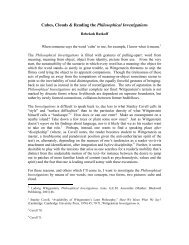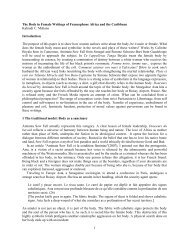Classification - Uwi.edu
Classification - Uwi.edu
Classification - Uwi.edu
Create successful ePaper yourself
Turn your PDF publications into a flip-book with our unique Google optimized e-Paper software.
Empire<br />
Kingdom<br />
Phylum<br />
Class<br />
Order<br />
Family<br />
Genus<br />
Species<br />
BIODIVERSITY I<br />
BIOL 1051<br />
TAXONOMY<br />
Professor Marc C. Lavoie<br />
marc.lavoie@cavehill.uwi.<strong>edu</strong><br />
Main taxonomic ranks<br />
Eukaryota<br />
Alveolata<br />
Ciliophora<br />
Nassophorae<br />
Peniculada<br />
Paramecium<br />
Paramecium<br />
aurelia<br />
Eukaryota<br />
Opistokonta<br />
Basidiomycota<br />
Hymenomycetes<br />
Agaricales<br />
Amanitaceae<br />
Amanita<br />
Amanita virosa<br />
Eukaryota<br />
Archaeplastida<br />
Chlorophyta<br />
Chlorophyceae<br />
Volvocales<br />
Chlamydomonadaceae<br />
Chlamydomonas<br />
Chlamydomonas<br />
eugametos<br />
Criteria for the classification<br />
of organisms<br />
• Morphological<br />
• Physiological<br />
• Metabolic<br />
• Ecological<br />
• Genetic*<br />
• Molecular*<br />
Definitions<br />
• Taxonomy: Science of biological classification.<br />
– <strong>Classification</strong>:<br />
• « Natural »: mutual similarities<br />
• Phylogenetic: evolutive relationship.<br />
– Nomenclature:<br />
• attribution of names to taxonomic groups in<br />
accordance with the published rules.<br />
– Identification:<br />
• Practical aspect of taxonomy. Process by which it<br />
is determined that a particular isolate belongs to a<br />
known taxon.<br />
Main taxonomic ranks<br />
• EMPIRES:<br />
• ARCHEA<br />
• BACTERIA<br />
• EUKARYA<br />
• GENUS<br />
• SPECIES<br />
Main organisms classification<br />
systems<br />
• Two Kingdoms System<br />
• Five Kingdoms System<br />
• Six Kingdoms System<br />
• Eight Kingdoms System<br />
• Universal Phylogenetic Tree<br />
(The Tree of LIFE)<br />
1
Two Kingdoms System<br />
Animalia Plantae<br />
• CLASSIFICATION<br />
CRITERIA<br />
• Mode of Nutrition<br />
• Metabolism<br />
• Mode of<br />
Reproduction<br />
• Type of Motility<br />
• Morphology<br />
Five Kingdoms System<br />
Eight Kingdoms System<br />
• Two Empires and eight<br />
Kingdoms.<br />
• Empire Bacteria: Eubacteria &<br />
Archaea.<br />
• Empire Eukaryota: Six eukaryotic<br />
Kingdoms. Two new Kingdoms:<br />
• Archezoa: Unicellular eukaryotes<br />
(Giardia) no Golgi, mitochondria,<br />
chloroplasts or peroxysomes.<br />
• Chromista: photosynthetic,<br />
chloroplasts in the lumen of RER.<br />
(Diatoms, Brown algae,<br />
Cryptomonads & Oomycetes).<br />
Two Kingdoms System<br />
Six Kingdoms System<br />
• Monera or<br />
Prokaryotae were<br />
divided into two<br />
kingdoms:<br />
• Eubacteria<br />
• Archaea<br />
RECENT CLASSIFICATION<br />
2
Universal phylogenetic tree<br />
• Bacteria:<br />
– prokaryotes,<br />
– membrane lipids : diesters of<br />
diacyl-glycerol,<br />
– rRNA :16S.<br />
• Archaea:<br />
– procaryotes,<br />
– membrane lipids : tetraethers of<br />
diglycerol or diethers of<br />
isoprenoid-glycerol,<br />
– rRNA: 16S.<br />
• Eukaryota:<br />
– eukaryote,<br />
– membrane lipids : diesters of<br />
acyl-glycerol,<br />
– rRNA: 18S.<br />
BACTERIA<br />
ARCHEA<br />
EUKARYA<br />
3
Cavalier-Smith, 2004<br />
Patterson<br />
1993<br />
<strong>Classification</strong> based on the<br />
acquisition of organelles<br />
T u b u l i n a e<br />
F l a b e l l i n e a<br />
S t e r e o m y x i d a<br />
A c a n t h a m o e b i d a e<br />
A M O E B O Z O A E n t a m o e b i d a<br />
M a s t i g o m o e b i d a<br />
P e l o m y x a<br />
E u m y c e t o z o a<br />
I n c e r t a e s e d i s<br />
S p o n g o m o n a d i d a<br />
F u n g i<br />
O P I S T O K O N T A M e s o m y c e t o z o a<br />
C h o a n o m o n a d a<br />
M e t a z o a<br />
C e r c o z o a<br />
H a p l o s p o r i d i a<br />
R H I Z A R I A F o r a m i n i f e r a<br />
G r o m i a<br />
R a d i o l a r i a<br />
G l a u c o p h y t a<br />
A R C H A E P L A S T I D A R h o d o p h y c e a e<br />
C h l o r o p l a s t i d a<br />
C r y p t o p h y c e a e<br />
E U K A R Y O T A C H R O M A L V E O L A T A H a p t o p h y t a<br />
S t r a m e n o p i l e s<br />
A l v e o l a t a<br />
F o r n i c a t a<br />
M a l a w i m o n a s<br />
P a r a b a s a l i a<br />
E X C A V A T A P r e a x o s t y l a<br />
J a k o b i d a<br />
H e t e r o l o b o s e a<br />
E u g l e n o z o a<br />
A n c y r o m o n a s<br />
A p o s o m o n a d i d a e<br />
C e n t r h e l i d a<br />
I n c e r t a e s e d i s C o l l o d i c t y o n i d a e<br />
E b r i a c e a<br />
S p i r o n e m i d a e<br />
K a t h a b l e p h a r i d a e<br />
S t e p h a n o p o g o n<br />
Unikonts<br />
Bikonts<br />
Adl et al 2005<br />
4
SIX CLUSTERS OF EUKARYOTES<br />
• 1. AMOEBOZOA<br />
• 2. OPISTOKONTA<br />
• 3. RHIZARIA<br />
• 4. ARCHAEPLASTIDA<br />
• 5. CHROMALVEOLATA<br />
• 6. EXCAVATA<br />
MICRO-ORGANISMS<br />
PROKARYOTES EUKARYOTES<br />
VIRUSES<br />
BACTERIA ARCHAE A AMOEBOZOA OPISTOKONTA<br />
RHIZARIA ARCHAEPL ASTIDA CHROMALVEOLATA EXCAVATA<br />
5
















